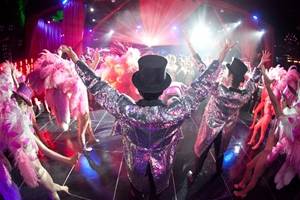
In a world where consumers are more likely to shell out for concert tickets than buy their favorite band’s merchandise, there’s no doubting the power of experiences.
Consumers today want a brand they patronize to enrich their lives, not just fill their closets or decorate their walls.
That’s why brands were predicted to increase their spending for experiential marketing 11% in 2017—nearly double from just two years ago.
That said, to deliver truly transformative experiences, brands must challenge the traditional take on events and tradeshow exhibits.
We’re entering a new generation of experiential marketing that considers cultural context, program timing, content development, and positioning within a brand’s long-term business objectives.
Beyond the Tradeshow Floor
At my agency, we’ve noted a trend: Industries are taking experiences outside their core contexts—tradeshow floors, terminals, and hotels—and fusing them with other players to reach new markets of consumers. Consider the automotive industry, for example: In 2018, it’ll move away from undifferentiated ride-and-drive events into broader-reaching experiential initiatives that integrate industries beyond the obvious markets.
Using better insights to expand your experiential efforts, you can go beyond the places your brand normally advertises and activates.
We recently worked with luxury brands Lincoln Motor Company and Dream Hotel in a strategic partnership for their second iteration of Dreamscape, a series of intimate media previews of the future Lincoln lineup, headlined by Dream Hotel’s Hollywood flagship. The experience generated mass awareness through shared content produced by lifestyle bloggers, influencers, and each brand’s audience.
Experiential can and should be used as an effective catalyst in the context of longer purchase cycles. Your brand can insert itself early in the buyer journey by having a culturally relevant presence in consumers’ lives—often, in places they wouldn’t expect. That way, when consumers do reach the purchase phase, they’ve already taken your brand into consideration.
Filling a White Space in Your Marketing Strategy
Here are some best-practices to integrating experiential activations into your comprehensive marketing strategy to boost customer sentiment and drive return on investment.
1. Focus on timing and consider context
An event can be a great way to capitalize on initiatives in ancillary channels. Think product launches, software updates, or an event that’s important to your target market. Timing, in that regard, is key.
For example, last fall, when Netflix premiered “Gilmore Girls: A Year in the Life,” the video streaming company coordinated pop-up versions of Luke’s Diner. Fans could immerse themselves in the experience of the cult-favorite coffee shop and feel a connection to their favorite characters. Some fans might have enjoyed the experience regardless of when it happened, but visiting Luke’s Diner right as the reboot aired was priceless.
Look at other projects in your pipeline, and time activations to boost the success of those projects. What big event is happening in 2018 that will connect with your audience? Start looking at quarters three and four now because you’ll need several months to plan and get all the pieces in place.
2. Account for pre- and post-activation amplification
An experience doesn’t begin and end the day of the event; if you’re approaching it from that standpoint, you’re not going to get the results you want. Instead, make sure you’re incorporating email, out-of-home advertising, and social campaigns to maintain the buzz around your event.
Influencer partnerships are extremely valuable in this endeavor. Consumers inherently trust their favorite bloggers more than they trust your brand.
When you’re selecting partners, don’t let a certain influencer’s star power drive your decision. A smaller, more niche influencer may not be a household name, but his or her followers are about 60% more engaged.
Influencers can drive organic interest around your event, share exciting content to induce feelings of fear of missing out, and act as your biggest advocates well after guests have gone home.
3. Commit to the investment
It’s the nature of business to aim for the most fruitful results at the lowest spend. However, making the most of an experiential activation may mean a larger investment up front.
Fortunately, the potential return on investment is well worth it. Experiences are unique in that they are one of the most effective ways to foster one-on-one connections with target consumers. A truly immersive experience will engage consumers’ sense of touch, smell, sight, sound, and sometimes even taste. When it’s done well, consumers will treasure the experience for life.
According to data from the Event Marketing Institute, 72% of consumers say they view brands that provide quality experiences more positively, and nearly three-quarters noted that when they can engage with a brand’s experience, they’re more likely to invest in its products or services.
4. Understand the larger business objectives
As with any marketing initiative, start with your objectives—or how you determine success. Then, decide how you’ll collect the data you need to track consumers’ path through the conversion funnel.
For instance, are you trying to ramp up excitement around an upcoming product launch? Then perhaps you should focus on survey responses or the likelihood of future engagement with your brand. Craft a plan to ensure this targeted data is captured—without disrupting the overall experience. We’ve seen great success integrating gamification through RFID wristbands to collect insightful consumer information from our client’s target consumers.
Quantifiable analytics that are seamlessly woven into an experience deliver calculated impact to prove ROI, optimize future campaigns, and inform business objectives.
* * *
Unlike passive forms of marketing, experiential is an active, multidimensional vehicle that connects with customers on a deeper, more emotional level. Experiences are physical personifications of the lifestyle your brand wants to portray—and they bring consumers into that lifestyle in meaningful ways.